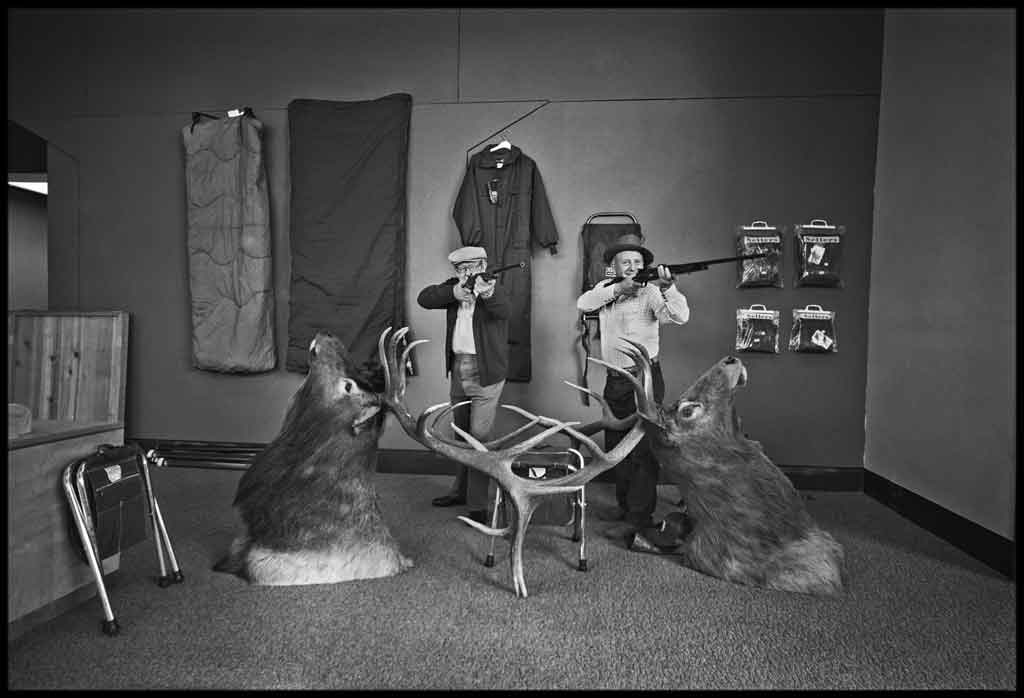The late photographer John Bauguess was born in Eugene in 1943 and died in early 2020. Aside from a few early adventures — brief stints in Seattle, San Francisco and outer Oregon — his intervening years were spent almost entirely in Lane County. He settled as a young adult in Dexter, in the home where he’d grown up, attending Pleasant Hill High School and where he later cared for his aging mother. This became his base as Bauguess embarked on a multi-decade career tackling various Oregon photo projects.
Throughout the 1970s and ’80s he was a whirlwind of activity, documenting the redevelopment of downtown Eugene, migrant farm workers, the filming of Animal House in Cottage Grove, the courage of homeless people, wolves, Grange Halls, and more. He was a regular at parades, fairs and other civic gatherings. “I think of myself as a recorder of contemporary Oregon history,” he once told an interviewer.
By dutifully documenting cherished local figures, Bauguess gradually became one himself. The memorial retrospective John Bauguess: A Life Through His Lens is a token of Eugene’s appreciation. Curated by his close friend Jack Liu from simply framed 11×14 chromogenic prints, it samples from all of the projects above. They’re clumped loosely by subject along the outer walls of Maude Kerns main space, 65 pictures in all. They begin immediately to the left of the entrance with a cluster of migrant worker photos.
Farther along the east wall is a sequence documenting early 1970s Eugene. Pope’s Ice Cream and Donut Shop anyone? The beloved diner is shown, along with Loren’s Barbershop, Brass Rail Tavern and their cheery clients. These photos sit directly opposite small grids of rural fiddlers and Kesey acolytes on the west wall.
Poor Parvin Butte makes an appearance, too, its besieged mass overshadowing a handful of color frames in the rear alcove. As a concerned neighbor, Bauguess actively campaigned against its destruction, and his photo exhibition Silent Witness raised the battle cry at Maude Kerns in 2012. Despite his efforts, the butte succumbed, at least metaphorically, to the wrecking ball, as did much of old downtown.
These photos chronicle the vernacular, and they’d be sufficient legacy for any local shutterbug to hang his hat on. But they are not the show’s main attraction. This role falls instead to the in-between moments caught by Bauguess, the “sometimes mysterious whimsicality of life’s fleeting vignettes,” as he describes them in the show’s brief looping video. Pulling strong photos from mundane situations is akin to pulling a rabbit out of a hat. There’s nothing there. Nothing, nothing, nothing — then voila! A picture comes together. The hunt for such moments is a constant challenge, and Bauguess was exceptionally proficient.
Whether capturing bystanders on a Seattle ferry, the awkward posture of a so-called “Assman” in Portland, or the dawn of awareness among picnickers in Independence, he was alert and ready. Bauguess had an innate sense for vantage and timing, a sensitivity to chance juxtapositions and, perhaps most importantly, a razor sharp wit.
Onlookers at a BMX track became a beguiling puzzle before his lens. Metal detectors in “Red Hill” framed an unlikely bystander dribbling a basketball. In the photo “Rabbit Deer,” shot at the Springfield Christmas parade, a plain car interior transformed into a mysterious animal diorama.
For a photographer so steeped in photojournalism, the irony of such photographs is that they seemed to invent fictions from whole cloth. Nevertheless, Bauguess was drawn to the chase, delighting in the endless games it invited and finding photo sustenance in unlikely permutations. I can’t presume to know his artistic priorities, but it’s worth noting that fleeting vignettes formed the core of his only previous retrospective, the 2010 exhibition Why Not? at Blue Sky Gallery in Portland.
That was 13 years ago. The current show is broader. It’s a celebration of life, not a focused venture. Fittingly, Bauguess’s in-between gems are sandwiched here and there between other projects. Staged outside the spotlight they still manage to steal the show. One example guards the gallery entrance, a large frame of a napping man shot through a car door. He’s been hard at work, and now takes an in-between moment to rest in peace.
John Bauguess: A Life Through His Lens is at Maude Kerns Art Center, 1910 E. 15th Avenue, through April 28. Hours 10 am to 5:30 pm Monday through Friday and noon to 4 pm Saturday.
